#soil digger
Explore tagged Tumblr posts
Text
Hey why do I sweat so much doing yard work if my Apple Watch doesn’t even register it as “exercise”
15 notes
·
View notes
Photo
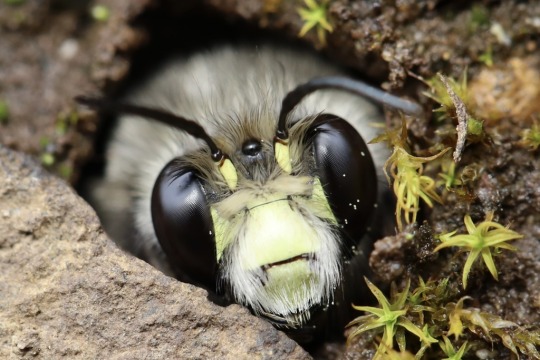

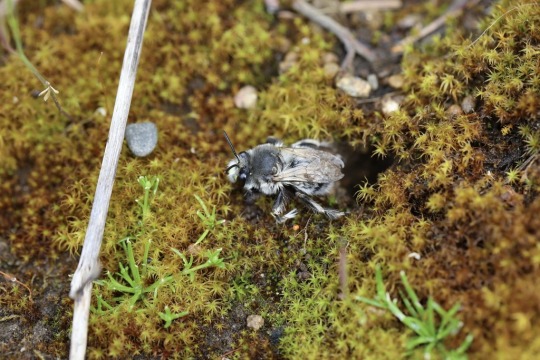
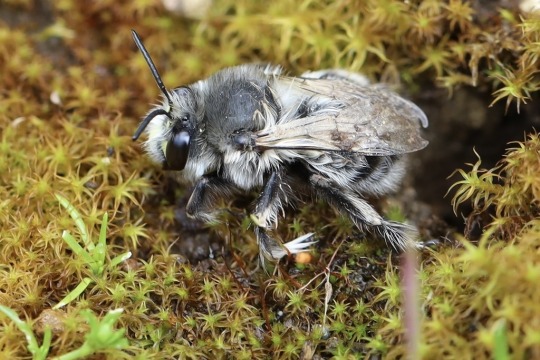

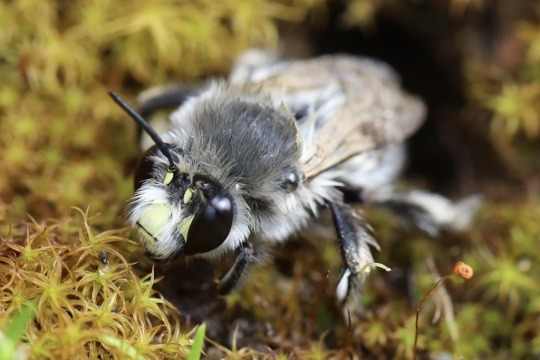
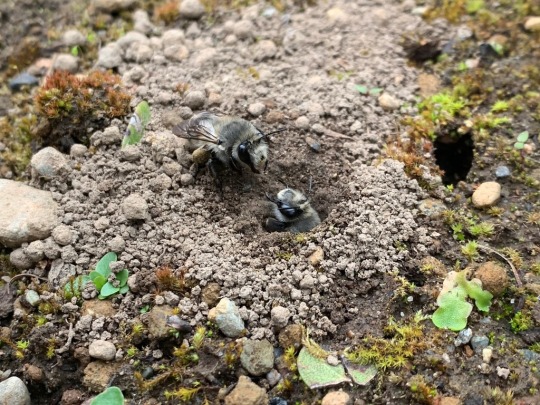

Pacific digger bee, Anthophora pacifica, Apidae
As the name suggests, digger bees make nests in the soil where larvae develop in cells. They are solitary, though they may nest in large aggregations.
Photographed in Washington state by eebee
#animals#curators on tumblr#insects#bugs#bee#common digger bee#digger bee#pacific digger bee#one nice bug#i included that last photo so we could all admire the Bee Butt
5K notes
·
View notes
Text

Squirmeon (Bug/Ground)
#??? - On rare occasion, an Eevee can be affected by more than one environmental factor, and reacts to grow into a new, rare evolution. Eevee who spend much of their time underground, searching for bugs and earth to eat, may evolve into the Bug/Ground-type Squirmeon. Excellent diggers and burrowers, these Eeveelutions travel where ever soil is moist and laden in minerals. When they move on to a new area, they leave behind enriched soil and a labrinth of tunnels that other Pokemon like to inhabit. Squirmeon spend the majority of their time underground, resulting in poor eyesight; however, their highly sensitive skin detects even the slightest ground vibrations, enabling them to navigate without issue. To stay healthy, they must keep their skin's thin film moist; if it dries out, they become unwell and must burrow back into the earth. Their diet consists mostly of soil and decayed vegetation. They will store nutrients and minerals in the rubbery sections of their tail and body, which they can draw upon in times of need. Though these easygoing Pokémon make excellent companions, Squirmeon are hard to find due to their underground lifestyle. Trainers who aim to evolve their Eevee into this Bug/Ground-type must encourage their Eevee to dig and consume mineral-rich soil.
Other dual-type Eeveelutions
- - - - - - - - - -
Follow for more Dual-Typed Eeveelutions!
FAQ | Social Media | Pokemon Index | Commission Information
#pokemon#fakemon#in progress pokemon#eevee#dual type eeveelutions#hybrid eeveelution#bug type#ground type#dual type eeveelution#hybrid eeveelutions#Eevee: “Would you still love me if I was a worm?”#Squirmeon#eeveelution#eeveelutions
991 notes
·
View notes
Photo

⚔️ 𝗡𝗲𝘄 𝗶𝘁𝗲𝗺! Grave Digger
Weapon (greataxe), rare (requires attunement) ___ This axe doubles as a magical spade, allowing you to excavate twice as much with it as a normal shovel. You gain a +1 bonus to attack and damage rolls made with this magic weapon, or +2 if the target is undead. When you reduce a creature to 0 hit points with this weapon, it can’t gain the benefit of any effect that would allow it to remain at 1 hit point or otherwise prevent it from dropping to 0 hit points. Whenever you slay a humanoid with this axe, you can choose to cause its corpse to be immediately and magically buried beneath 5 feet of earth (provided it was on soil when slain). At the end of your next turn, that creature’s corpse resurfaces from the earth as a zombie under your control, unless you already have two zombies under your control. Zombies created in this way take their turn as a group immediately after you. They obey your verbal commands (no action required). If you issue no commands, each zombie only defends itself against hostile creatures. Once given a command, the zombie continues to follow it until its task is complete or until you issue a new command. Each time you create a zombie in this way, roll a d6. On a 1, the zombies no longer obey your commands and are hostile towards you and your companions; the zombies also become hostile if you’re reduced to 0 hit points. Otherwise, a zombie remains for up to 8 hours, at which point it becomes a normal corpse again. ___ ✨ Patrons get huge perks! Access this and hundreds of other item cards, art files, and compendium entries when you support The Griffon's Saddlebag on Patreon for as little as $3 a month!
201 notes
·
View notes
Note
I have to ask about my top 5 favorite boys Dunsparce! I know all it's Pokédex entries talk about it burrowing underground BUT!!! What if like. You raise it from an egg or catch it so it's used to humans instead of just a wild one and give it a backyard to like. Use it like a bigger Pokémon version ant farm situation and try to keep it outside or not to drill in the house/make sure to make it feel safe so it doesn't on instinct? That's GOTTA be a at least a B-tier then, right??? (I may be coping a little but sue me, I think Dunsparce is a silly guy that is severely underated, at least before S/V came out.)

(Hey! It’s the pokémon in the blog’s pfp at last!) While I unfortunately can’t give dunsparce the glowing B-tier rating you were hoping for, but I also can’t say that a dedicated owner would be entirely unable to care for one. It won’t be easy (or cheap), but certainly not impossible. Let’s get into it, this is a long one.
To begin with, dunsparce are pretty big. At nearly five feet long, these surprisingly quick pokémon need a lot of space to move around. Thankfully, they aren’t too heavy, so you shouldn’t have too much trouble carrying them around with a big bear-hug. Now, as you pointed out in your post, dunsparce do require some specialized space to be happy and healthy, which will likely present some problems for a lot of potential owners.
Wild dunsparce make their homes underground in (I like the way you put it) giant, maze like ant-farm structures (Crystal, Ruby/Sapphire, Diamond/Pearl/Platinum). They have been known to share these burrows with other ground-dwelling pokémon like digletts (Ultra Sun), so if you are already the proud owner of a burrowing pokémon you may already have what you need for a dunsparce. Given their size, dunsparce need a lot of dirt to dig around in, which could be a problem when it comes to the size of your home and/or yard. Thankfully, while these pokémon are skilled digger with their drill-like tail, they aren’t exactly avid explorers: once a dunsparce has a nest they are happy with, they’ll spend most of their time inside it, remaining “virtually motionless” (Crystal). So, while you probably won’t have problems with your dunsparce running away from home, you will need to make sure they have adequate space. The larger your yard, the more likely the space will be adequate for a dunsparce. Because of their size, a simple sand/soil box won’t cut it (this is where the potentially expensive part of owning a dunsparce comes in).
Because they spend most of their time underground, it is important to have proper expectations about socializing with your dunsparce: these pokémon aren’t really the cuddly, indoors type. In fact, wild dusparce are known to be very skittish, especially around humans. According to the pokédex, dusnaprce tend to run away as soon as they’re aware that a human has spotted them, burrowing into the ground as fast as they can (Gold, Ultra Moon). In your request, though, you brought up an interesting question: would a dunsparce raised from birth be more comfortable with humans? As with most animals, I would have to guess that the answer would be yes (this isn’t really something I’ve explored on this blog before, so it’s an interesting avenue to go down!). Keep in mind, though, that these pokémon are pretty rare due to their fear of humans in the wild, so getting a dunsparce egg might be pretty expensive, and you’ll want to do your research to ensure that you’re buying from an ethical pokémon breeder.
Due to their aforementioned fear of humans, dunsparce are far more likely to choose flight over fight in most situations. This means that they aren’t exceptionally dangerous to humans. Their drill-like tail allows them to use powerful moves like Hyper Drill and Drill Run. While these moves could really do some damage to a person, they’re much more likely to cause damage to the environment around them when they try to flee. It would not be a good idea to bring a dunsparce inside unless it is some sort of indoor space where they can comfortably dig if they feel threatened. The only dangerous dunsparce is a dunsparce that feels cornered in a space where they can’t dig.
If you are able to provide a dunsparce with the large nesting space that they need, they are a pretty easy pokémon to care for. They’re laid-back but skittish, but get along well with other burrowing pokémon. While I can’t recommend them to all pet-owners, those with the right resources and dedication could find a great pet in this pokémon. Be careful though: if your dunsparce knows the move Hyper Drill, they are much more likely to evolve into the much larger, much more difficult-to-care-for dudunparce! I’d recommend the use of an everstone, just in case.
56 notes
·
View notes
Note
Can we get headcanons for nonhuman Epel? I feel like he's often overlooked even though you seem to have a soft spot for him
While I will enjoy whatever you decide his nonhuman counterpart to be, I ask you to consider him as a bunny boy
Rabbits are very cute but their bites can tear up tendons and their kicks could kill smaller animals hedgehog riddle so don't let the appearance fool you
Hmm, I don't have a whole lot right now but...
Vil really hates Epel's need to dig.
Rabbits are natural diggers. Blame it on their wild cousins who burrow for nesting. House rabbits dig for fun, too. It... can also lead to him possibly "rearranging" the Pompom dorms carpet, or sneaking out and getting himself pretty dirty, looking satisfied till Vil has him by his scruff.
He can't help it, it's in his nature and the smell of the soil reminds him of home. Don't be surprised if he tries making his own burrow under Ramshackle, he thinks no one knows about it but Rook does...he always does.
Chinning...ever notice your rabbit rubbing its chin on things? It’s marking its territory with invisible bunny graffiti. “This human? Yep, they're mine.” His scent glands are under his chin so expect that to be getting rubbed on you, along with getting covered in his lavender fur, bunnies shed a lot.
He sure as heck has strong kicks but do you know just how bad those claws can be? My grandpa grabbed a wild rabbit the wrong way and that little thing cut up strips of skin and flesh on his arm and bled like crazy. Epel is gonna kick, scratch, and bite and come back to you with a torn-off piece of the guy's uniform in his mouth as a trophy, looking proud and cute with a flick to his tail.

Speaking of tails did you know bun tails are actually a bit long?

Though you're admittedly the only one who's going to find out since he's not going to let anyone else mess with it.
He's def an angry foot thumper who gets even angrier when told how adorable he looks doing it.
136 notes
·
View notes
Text
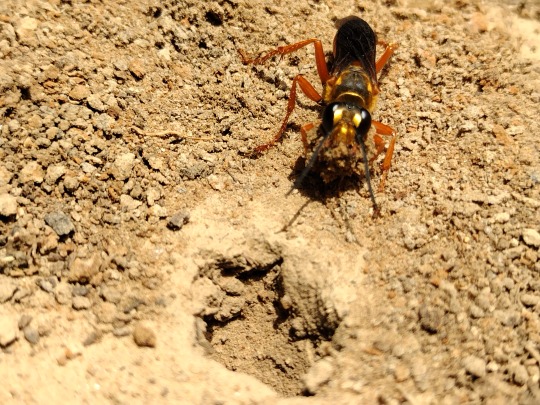
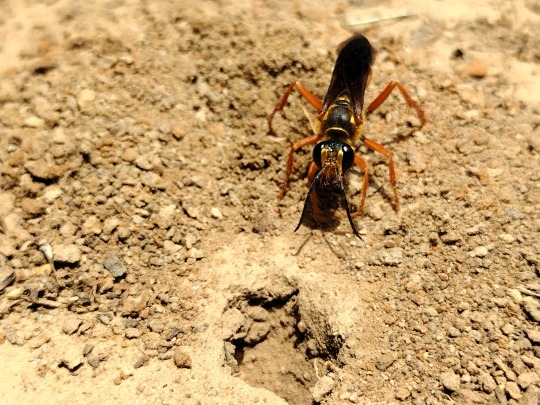
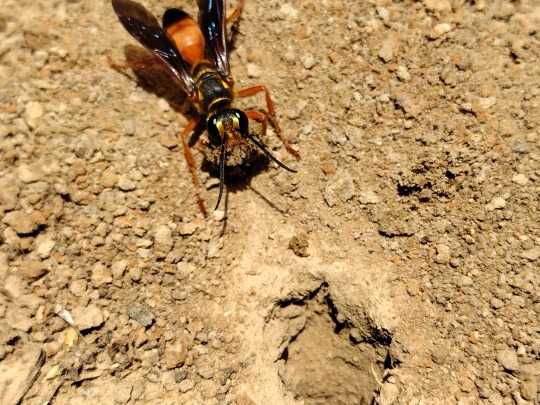

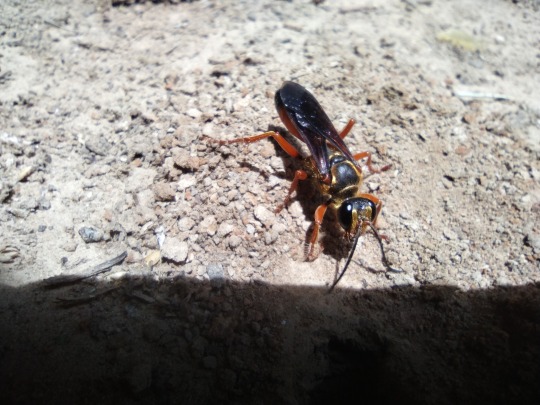
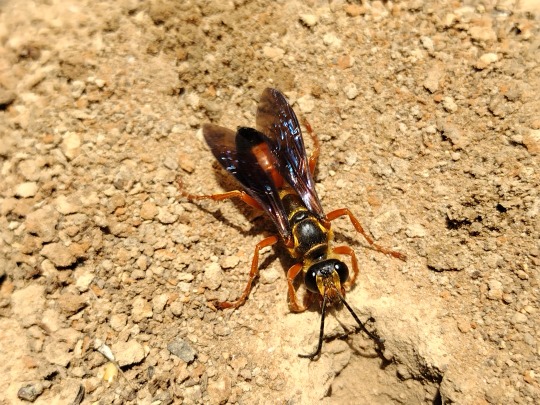
[VIDEO AND PHOTOS TAKEN: JUNE 8TH, 2024 | Video and Image IDs: Two stitched together videos and six photos of a yellow, orange, and black great golden digger wasp digging out a burrow in a patch of dry and light soil, going exiting the hole metasoma-first with big chunks if dirt /End IDs.]
One of my favorite types of wasp working hard to provide her young with a suitable burrow 🥰
#Wasps#Wasp#Great Golden Digger Wasp#Sphecidae#hymenoptera#insects#insect#bug#bugs#bugblr#entomology#arthropods#invertebrate#photos#photo#Video#Wasp House Sights#videos
71 notes
·
View notes
Text
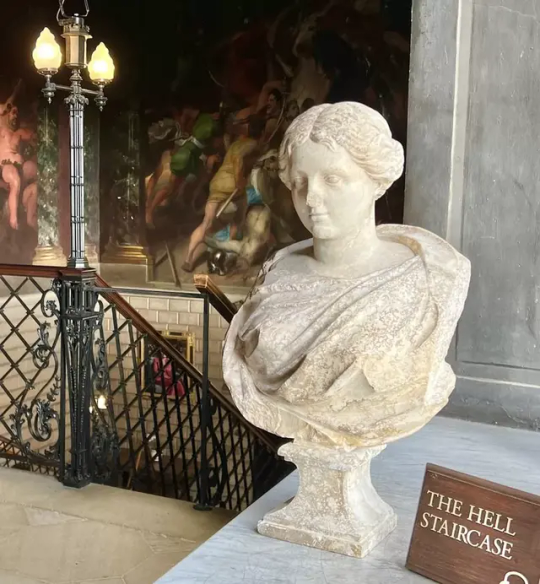
Roman Sculptur Head and Bust Discovered at Burghley House in England
A mysterious 1,800-year-old Roman statue has been unearthed during car park construction work.
Now taking pride of place on display within the dramatic Hell Staircase at Burghley House, the marble head of a Roman lady was discovered by a digger driver in spring 2023, closely followed two weeks later by a marble bust.
After being cleaned, experts dated the sculpture from the First or Second Century, with an iron dowel added later, allowing it to be attached to a bust or pedestal.
This type of adaptation was often carried out by Italian dealers in antiquities during the late 18th Century to make excavated ancient fragments more attractive to aristocrats travelling in Italy on what was known as the Grand Tour.
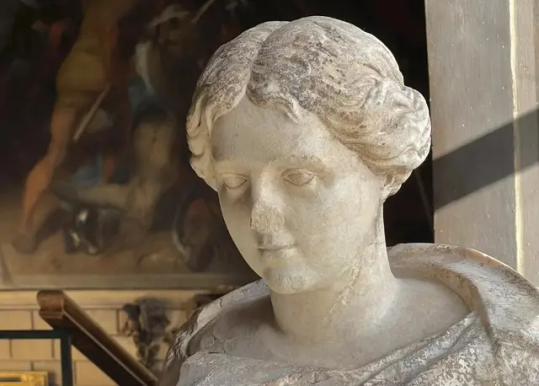

It is believed that it was during one of the ninth Earl’s two tours to Italy in the 1760s, when he purchased many antiquities, that he brought the sculpture back to Burghley.
But it remains a complete mystery how the head and bust ended up buried in the park, with explanations ranging from a bungled burglary to someone simply discarding the statue and it later being covered by soil.
It is also unclear how long it has remained hidden underground before being discovered in late April 2023 when the new car park was nearly complete.
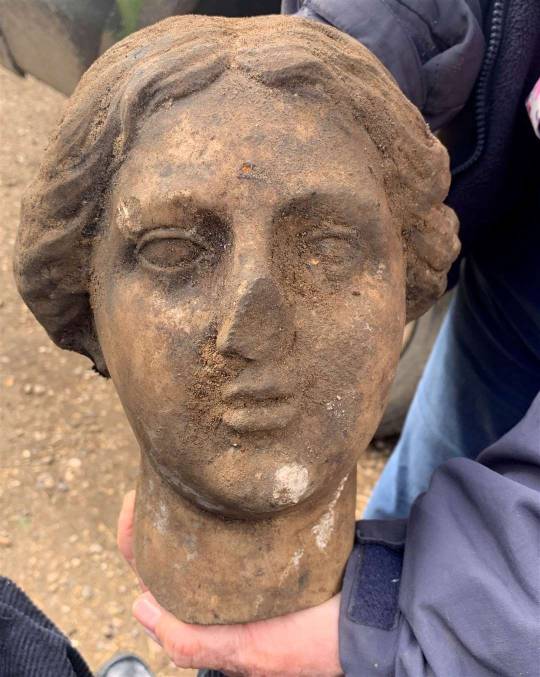
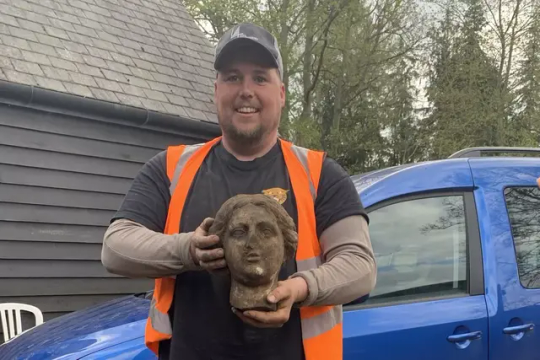
It was during work on an overflow parking area, at the edge of the main site, that digger driver Greg Crawley noticed a pale object amongst the lifted earth, which turned out to be the head. Thrilled with the discovery of the ancient artifact, to everyone’s amazement just weeks later a second discovery was made within a short distance of where the head was found, when the bust was also unearthed.
Both items were immediately taken to Burghley’s Curator before being sent to a professional conservator who was able to carefully clean and consolidate the figure, revealing the features of a beautiful Roman lady, before reassembling both pieces as they had been intended. The find was also reported to the British Museum, which maintains a database of such discoveries.
And when the House opens again for the 2024 season, on 16 March, the remarkable find will be on display, together with an explanation about its discovery, and alongside other sculptures that were purchased by the ninth Earl.

#Roman Sculptur Head and Bust Discovered at Burghley House in England#Burghley House#marble#marble statue#marble sculpture#ancient artifacts#archeology#archeolgst#history#history news#ancient history#ancient culture#ancient civilizations#roman history#roman empire#roman art
135 notes
·
View notes
Text






Just impulsively designed this silly mf- a httyd-style pangolin dragon!! Hope yall like it, keep reading for some fun facts…
Fun facts about the Pangolin dragon
-Tongue can be up to eight foot long, as long as their bodies minus the tail
-they eat grubs, worms and other insects in the wild, but can be given any sort of meat if it’s ground down into a paste, they really just need a protein smoothie
-mainly a ground dwelling dragon, they only have wings so they can fly to a few designated meeting islands once a year to mate and rear young
-once the babies are old enough to fly short distances either the male or female dragon will carry them back to their territory on their backs to raise them into adulthood
(For this reason it is especially easy to get them used to being ridden!)
-They are not an aggressive species, preferring to curl up in a ball at the first sign of danger.
-They are constantly foraging in the wild in order to find enough to eat
-they live exclusively on the southern islands, where it’s warm enough to support their food source. However the northern leaning Panglo-dragons have been recorded to hibernate through the cold months
-They are skilled diggers with digging spurs on their front wings that act like shovels almost, allowing them to chip into the hardest soil, they use this to find food and make burrows/nests!
-Due to their vast territories, these dragons are quite rare, and breeding programs are made difficult with the fact adult Panglo-dragons don’t exactly enjoy eachothers company…
41 notes
·
View notes
Text
America Runs On Corn!
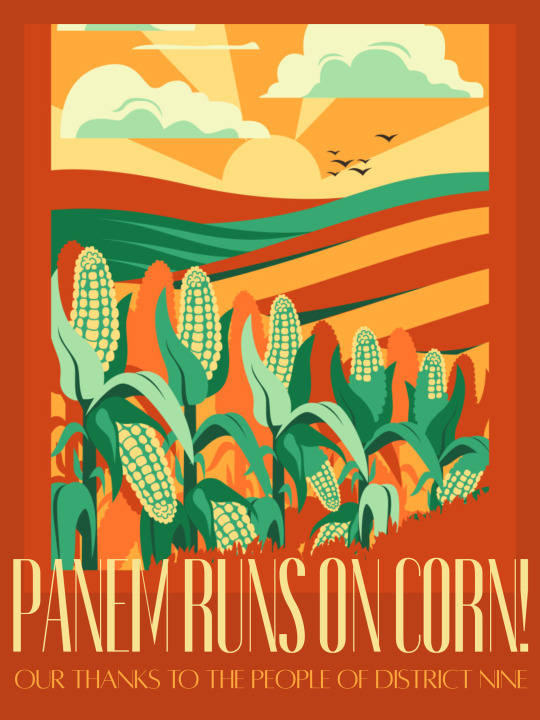
(featuring me ranting about sustainable agriculture in the form of a fanfiction excerpt below the cut... and why I think District Eleven was Panem's most important District)
Underneath the artillery hangars, cavernous halls were already beginning to take shape. Scientists from above ground, clearly out of their element, milled about, placing soil in raised beds. The seed samples his platoon had collected in Eleven sat prudently in glass vials, waiting to be planted.
The research he had been tasked with for eighteen months finally revealed its importance– the Capitol must have known about the rebellion in Eleven, perhaps it had taken root years ago. And they were petrified. Thirteen, Three, and Five were the Capitol’s pride, their shining beacon of advancement, but the outer districts: Nine, Ten, Eleven– those were their life force. No society, no matter their technology nor military strength, could survive without something as simple as food.
Nine produced the bulk of their diets in the form of millions of tonnes of ration grain, but Eleven was Panem's champion of biodiversity. Wheat crops died out frequently in Nine, ravaged by disease that swept through monocultures just as quickly as a wildfire would decimate a brushfield in District Two.
He remembered a picture he’d seen in a textbook when he was still in school that read, cheerfully: Panem Runs On Corn! Our thanks to the people of District Nine. It was true, corn grown in Nine was turned into feed for cattle in Ten, fermented into ethanol to power the trains in Six, hydrolyzed into syrup as a cheap alternative for sugar. But for all its importance, it was ridiculously easy to wipe out. Once, when Arvada was ten, there had been some kind of soil virus that infected that year’s corn stock. Beef shortages followed, and interdistrict travel was entirely halted, leading to a famine of sorts in Six– who relied on the steady usage of their vehicles for revenue.
Wild corn grew in Eleven, its multi-colored grains hard and unappetizing, so unlike the sweet yellow stalks that coated the plains of Nine. But it was resilient– even if one plant were to die, withered from disease, the one beside it would remain unphased. It was the same for wheat and wild rice, soy, fruits and vegetables of any kind. The wild ones survived while the engineered ones– blueberries plumped to the point of bursting with hardly any flavor besides a sickening sweetness, oranges with berry-red flesh created out of pure scientific greed– died out at the merest hint of hardship.
He and the other officer recruits in his platoon had taken those wild plant strains and subjected them to all kinds of agricultural torture to test the extent of their durability. Now, those same seeds were being lovingly tucked into soil in l’abri.
Was this the Capitol’s foolish replacement for Eleven? Surely it wouldn’t provide enough food for the entire nation. A few thousand square meters underground could hardly replace the sprawling vastness of an entire District. The moment the thought crossed his mind however, it was superseded by another, far more realistic, explanation– it was very possible the Capitol didn’t intend to feed Panem at all, and would leave its people to starve while they cowered away, taking l’abri for their own.
What would become of them, the trench diggers that worked meters ahead of him, prodded along by the ever present threat of death strapped across Arvada’s chest? Brielle’s warning seemed to echo through the room, drowning out the deafening roar of machinery. “Where will we go when they need this place for their own?”
Six months, he repeated, looping the phrase in his mind like a prayer. Just six months, and you’ll never have to look at this place again.
#silly little chapter five teaser for those interested#or if you just want to listen to me rant about agriculture?#if you do I love you#also another Capitol propo from before the first-rebellion#this one's a little on the nose#but still
14 notes
·
View notes
Text
Wasps enter the stone age
Think about animals that use tools. The first ones that come to mind are probably us, other primates and birds. Some of you may think of octopods and even sea urchins. But we don't usually associate insects with tool use.
Here it's important for me to distinguish between tool use and construction. Construction can involve the usage of external materials to build structures that aid the animals - think carpenter bees and termites. Tool use, on the other hand, involves the use of external material to aid in a specific task. Crucially, tools are often discarded after the task is complete.
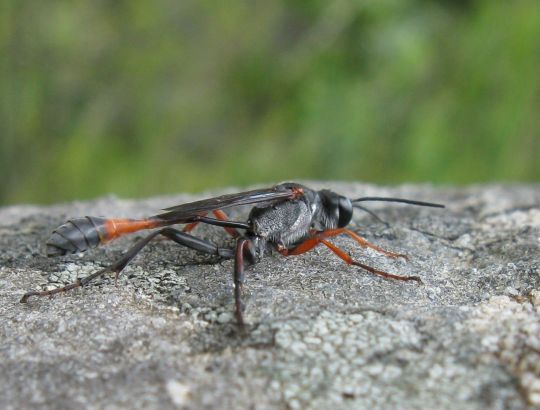
ID: a close-up image of a species of digger wasp, Ammophila ferrugineipes. It has a black body with orange sections on its abdomen and legs. The body is incredibly slender, more so than the more common yellowjacket wasps. It is sat upon a grey rock, and the background is a blurred green.
Digger wasps are a group of wasps that make a nest for their young by, you guessed it, digging. Whilst some wasps use their abdomens to pack down dirt, some use their heads and mandibles to do the same. And interestingly, almost all of these wasps are also NERDS and have figured out how to use tools. They'll take stones and pebbles and repeatedly tap the soil in order to compact it, thereby improving the structural integrity of their burrows. Whilst some then use those stones to block the entrance, most will just throw them away after use.
Isn't that cool? Wasps! In the stone age! Just goes to show that neural complexity and tool use don't really go hand in hand, and that surprising behaviours can develop all across the animal kingdom.
72 notes
·
View notes
Text
Calamite catacombs of Central Asia
Hello! This specproject is back.
Today we talk about zombie forests - Calamite catacombs:


WHAT IS CALAMITE CATACOMBS?
Calamite catacombs is are imagined ecosystem of Early Permian (300-280 m.y.a), which are the remnants of forests of tree ferns and conifers in the rapidly growing desert. In fact, the calamite catacombs are the hollow trunks of giant ferns buried under a layer of silt and sand deposited from the bottom of lakes, as well as volcanic ash. These trunks connect the upper layers of salt marsh soil and deep-lying rock with the remnants of old forest soil above and limestone with karst caves below.


Fern Calamites and conifers Cordaites
HOW THEY FORMED?
As we said, these ecosystems are rapidly deserted territories, similar in formation to the Aral Desert. Before that, forests grew in this area, consisting of conifers with surface roots like modern spruce and tree ferns with deep rhizomes. Desertification salted the soil and removed moisture - because of this, ferns stopped reproducing, and their terrestrial shoots died. At the same time, conifers were better adapted to the new conditions, but the absence of a taproot meant death from lack of water. However, already at these times, various types of trees could be connected by roots, so far without the participation of fungal mycelium. In fact, this led to the emergence of hybrids - half-dead trunks of ferns buried under the ground fused with the root system of gymnosperms.
This is how the zombie forest was preserved in the desert.
Usually these fragments of the forest represented the shape of crescents, as they grew near rivers and lakes and often groundwater is preserved under their roots. Moreover, hollow calamite trunks and roots helped moisture penetrate deep into the ground and gradually wash out the rock, forming new underground reservoirs. Finally, burrowing teliphones, originally preserved thanks to tree trunks, created a system of caves between dead dry trunks of ferns, and early spiders fastened them with webs.
Speaking of teliphones...
WHO LIVE IN CATACOMBS?


Surprisingly, the prehistoric vinegar spiders of Central Asia and modern teliphones of the USA are commensurate both in lifestyle and size
With the loss of habitat in the form of forest litter and the arrival of a harsh desert climate, teliphones were forced to quickly adapt to new conditions. Fortunately, acetic arachnids had predadaptations to a nocturnal lifestyle and digging in loose soil (modern species can dig holes up to 1.5 meters!). On the other hand, some arthropods are forced to seek shelter, and some could risk waiting out the sun in the tunnels of teliphones. Soon these aliens accepted the spider tunnels as their home, safe from external influences.
For teliphones, such a neighborhood has become advantageous: instead of going to the surface to hunt, you can now endlessly explore your passages in search of prey. Moreover, the expansion of the moves meant an increase in hunting grounds for their owner. It is not surprising that the evolution of vinegar spiders has gone towards an underground digger like a mole.

The first forms of catacomb teliphones did not differ much from modern ones. In the picture attached to the post, we can see Arachnetiflopontica margaritari - a pearl mole spider. This species differs from its terrestrial counterparts only in its more powerful pedipalps, elongated tail thread and forelimbs, and a special, mother-of-pearl color. The latter is a neutral mutation caused by a decrease in the amount of pigment in chitin and its increased transparency: it is typical only for females. They build their catacombs in loose desert soil, and in rare cases they are able to dig a passage through plaster layers in the sand created during rare rains. Often the passages of mole spiders are populated by ordinary spiders: they strengthen the tunnels with their webs. Teliphones are usually tolerant of such co-authorship - so far, spiders are not yet able to use their silk to catch prey. Nevertheless, mole spiders try to hunt such neighbors, restraining their spread through the catacombs: untreated walls are often overgrown with fungi, which gives food to prey.
Gradually, competition in the thickness of the sand increases, which is why some of the teliphones through the trunks of the calamites are trying to arrange lairs deeper and deeper into the ground. Eventually, these miners stumble upon the parent rock from the marine sediments. Here, the evolution of teliphones takes an unexpected turn: instead of developing stronger pedipalps, vinegar spiders acquire a flatter, flexible and elongated body shape, small limbs that make it possible to walk both forward and backward equally effectively, developed vinegar glands previously used to protect themselves from other animals. Often, the tail thread of such forms thickened and acquired outgrowths, becoming like a hard, thick corolla. An example of this form is Oxycoilia pachiapinelo whose name literally means "Acid belly with a tassel". This structure is easily explained by a simple chemical reaction: limestone, reacting with acetic acid, breaks down into acetate, water and carbon dioxide. Oxycoilia use this reaction to build their catacombs: they release an acetic aerosol onto the wall, rub it with a tail thread, after which they dig the softened rock with either their limbs or a thread. They rarely do this, preferring to use the moves created before them, as well as the trunks of the calamites. Often these acidic teliphones rise into the upper layers of the ground for hunting, after which they take the prey for storage in special chambers: their catacombs serve more as shelters from their fellow moles than as hunting sites. Oxycoilia also accumulate oxygen in the upper layers of the soil - there is incredibly little oxygen in their passage.
Let's say a few words about reproduction in the end. Vinegar underground spiders live long enough - up to 8 years. Like modern species, these spiders tend to take care of their offspring. During the breeding season, young male mole spiders go beyond the tunnels to go a long way in search of unfamiliar catacombs: at this time they lead the lifestyle of ordinary teliphones. Finally, they find tunnels of an alien population, where they mate with females without any problems. Some continue their journey, while the rest remain in the found catacombs.
And while the spiders are building their burrows, the trees will finally disappear due to old age: the terrestrial part of the catacombs will not live more than a millennium. However, underground, a network of burrows and trunks will create a universal bunker for any life hiding from the sun. One of them is the unusual sisters of modern amniotes who refused to invent the egg...
#spec evo#speculative biology#original species#paleoart#paleontology#fauns#spiders#paleozoic#illistration#art#permian
19 notes
·
View notes
Note
This may be a bit of a silly question but I’m trying to research this for a fanclan and I cannot make a fox’s tail out of the non twoleg workings
So how would you/Windclan go about reinforcing the tunnels? Used to think it was just ‘put a thick branch up there and every few fox lengths, it’ll support all that’ and that doesn’t seem quite right anymore. Please and thank you 🐈⬛
I'm gonna try and keep this reply simple and not get into the in-depth mechanics of digging holes, that's a post for some other time and I'd have to talk about depth and learn math and shit
So very simply putting it, usually, you would naturally dig square tunnels, and this is where all the tension of digging comes from. See, a square tunnel is really bad for physically holding things up, so beams are there to help.
Think about a tunnel kind of like building a bridge. The tunnel is a structure that needs to hold up the dirt above it. Really, functionally think about how many bridges are truly flat; it's not many! You want Arches.
And, it just so happens, a tunnel ALSO wants to be an arch. I'm not sure if I'm explaining this well so I drew a little diagram of a cave-in;
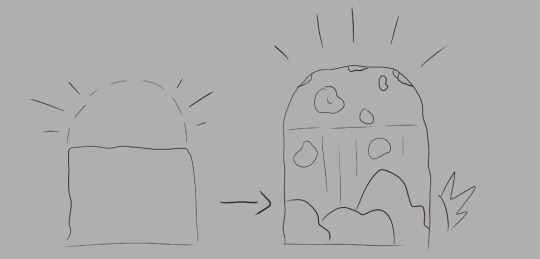
[ID: A drawing of a square tunnel with a dotted line showing the arch of where the dirt will collapse. It progresses into the second drawing of a rock fall, revealing the arch of the first drawing.]
Most cave-ins aren't the ENTIRE tunnel collapsing, it's the part of the tunnel that WANTS to be arch. Arches good. Arches are physically the best way for holding things up. Problem is that you can't dig like that without dropping however many pounds of earth on yourself.
So really, what you want is a beam, not just a stick in the middle of the hole. You want to put a beam from wall to wall, supported by two columns beneath. Like minecraft.
Other various things;
Older tunnels are, actually, usually more structurally sound. There's been more time for them to "stabilize."
The deeper the tunnel, the more stable. This is because the earth above the tunnel is packed in better. You do NOT want to open up a staircase downwards like minecraft, the entrance will COLLAPSE.
However, naturally, a collapse in a deeper tunnel is more deadly and severe for obvious reasons.
Just to state the obvious, sand bad. You do not want to dig in sand. Sand Bad.
Canon vastly overstates the severity of shallow tunnel collapses. Cats will die in less than a foot of dirt :/ There's this part in DOTC where Jagged Peak activates a quicktime event and a burrow collapses on him and it was so profoundly stupid it's been in my head ever since
suffocating in an old animal burrow... girl... do you think rabbits are constantly dying in collapses? genuinely? In soft soil?
Gray Wing is like, "you almost out bro?" and Jaggy-P is like, "ya im coming" and then WHOMP. DIRT. thats not how this works thats not how any of this works
And as a final note... the problems with WC's portrayals of shitty parents aside, it actually makes perfect sense that Tallpaw would think his father Sandgorse is a lunatic for feeling safe with going right back in after a collapse. Tallpaw doesn't know that some kinds of cave-ins actually make the tunnel more safe, but Sandgorse, an experienced digger, would.
(unfortunately the writers don't know this. but i do.)
#clan culture#tunneling#bone babble#bones gives advice#so really my answer is a glorified Ya Just Toss Up A Stick Every Few Foxlengths#HOWEVER#I am saying it should be THREE stick.#Two columns and a beam.
215 notes
·
View notes
Text



bunhill fields is a burial ground in the london borough of islington. it is not consecrated ground, and was the preferred resting place of religious nonconformists during its operation. the name is derived from “bone hill,” which refers to the possible deposition of thousands of dried bones on the site, covered with soil and forming a morbid hill. it is home to many famous graves, including john bunyan.
considered one of london’s most haunted burial grounds, bunhill fields will serve as the location for some dogs think their name is no chapter 12 “grave-digger,” out this friday!
#one of my fav parts about writing this fic is the graveyard research#bunhill fields#lockwood and co#lockwood & co#lockwood and co fanfiction#some dogs think their name is no#hollcwboy#eldritchterrcr
11 notes
·
View notes
Text
i think more high school stories need a scene where 2 teenagers and one of their moms trespass onto a farm and start digging in cursed soil. i love narratively important digging <3x3-chunk to-bedrock hole digger
50 notes
·
View notes
Text
Today's Domestic Duties
Oh dear, Diane has started calling me "Mrs Mopp" because I now get excited that I have finally found a cleaning product which removes lime scale from shower doors! In case you're wondering, this isn't the first steps in feminisation, "Mrs Mopp" is a generic English name for the archetypal char woman, or cleaning lady, often called a "daily woman".

I'm going as fast as I can, Diane!
I was mostly outdoors today, serving my good lady. My first job was to dig up some of the front lawn to make a new border. The soil was rock hard, so that wasn't easy. Then I needed to level out the gravel in our front drive; I was amazed at how much physical work that was - I suspect that I'm getting too old for hard labour. I also had a set-to with the weeds in the front drive. That should have been an easy job but I am currently having an attack of arthritis in my thumb, which makes squeezing the spray gun quite painful. All of this, just to serve Diane. She had a trip out with her friends to a local garden centre, which is exactly how things should be, her having fun and relaxing while I try to make her happy by doing all of the things which get in the way. I love it, and wouldn't have it any other way.
Then I cooked dinner, which we ate outside, followed by the washing up. The garden is looking so lovely now, although I only look after the lawns and do odd jobs like today's. The other week Diane wanted me to construct an edifice out of old bricks that she could stand plant pots on. I may have got a bit carried away, as we now have a Stepped Pyramid which almost rivals the one in Saqqara. I think have enough bricks left to make a full-scale copy of the Great Pyramid of Giza, but I won't suggest it; Diane has a tendency to take me literally! My last job was to drag an olive bush (in a terracotta pot) from the front to the back garden. I was only able to manage this thanks to my grandson's toy digger truck, which I used like a kind of sack barrow. It worked, and entertained Diane.
Ho hum, bathrooms tomorrow! That limescale had better watch out.
Brian
#female lead relationship#female led relationship#female led house#female led#wife led marriage#female led future#female led husband#female led worship#femaleled#wife in charge
4 notes
·
View notes